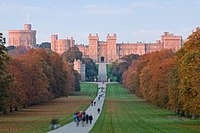File:Sir Edwin Landseer - The Connoisseurs (Portrait of the Artist with two Dogs).jpg

Original file (1,552 × 2,000 pixels, file size: 388 KB, MIME type: image/jpeg)
Captions
Captions
Summary
edit| Edwin Landseer: The Connoisseurs: Portrait of the Artist with two Dogs
|
||||||||||||||||||||||
|---|---|---|---|---|---|---|---|---|---|---|---|---|---|---|---|---|---|---|---|---|---|---|
| Artist |
artist QS:P170,Q328369 |
|||||||||||||||||||||
| Title | ||||||||||||||||||||||
| Object type |
painting object_type QS:P31,Q3305213 |
|||||||||||||||||||||
| Description |
In this self-portrait Landseer sits at a drawing board, a porte-crayon in one hand and two dogs behind him scrutinising his drawing. Although Landseer reportedly hated being watched while he worked, he liked having dogs in his studio. The two dogs depicted here are probably his own collie, Lassie (on the right), and a retriever called Myrtle, owned by Mr Wells, one of his patrons. In positioning the two dogs as connoisseurs of his work, Landseer implies that the untutored judge is better than the tutored. A photograph of the artist taken at around the same date (RCIN 2911991) suggests that Landseer used a mirror to make this self-portrait, as certain features appear in reverse. Interestingly, he seems to have been selective in the areas he corrects: his painting hand and the buttons on his jacket have been reversed, while his parting and the direction of both his crossed legs and his drawing board correspond to his mirror image. Perhaps the artist only corrected those aspects of his appearance that might arouse suspicion were they to appear back to front and he may even have used a photograph as a visual aid in the final stages of the painting process.[1] |
|||||||||||||||||||||
| Date |
1865 date QS:P571,+1865-00-00T00:00:00Z/9 |
|||||||||||||||||||||
| Medium |
oil on canvas medium QS:P186,Q296955;P186,Q12321255,P518,Q861259 |
|||||||||||||||||||||
| Dimensions |
height: 92.4 cm (36.3 in); width: 72.1 cm (28.3 in) dimensions QS:P2048,92.4U174728 dimensions QS:P2049,72.1U174728 |
|||||||||||||||||||||
| Collection |
institution QS:P195,Q1459037 |
|||||||||||||||||||||
| Accession number |
RCIN 403220 |
|||||||||||||||||||||
| References | Frederic George Stephens (1896) Sir Edwin Landseer, Illustrated biographies of the great artists, Sampson Low, Marston and Co., p. ix Retrieved on 4 April 2024. OCLC: 835252688. | |||||||||||||||||||||
| Source/Photographer | Royal Collection RCIN 403220 | |||||||||||||||||||||
| Other versions |
|
|||||||||||||||||||||
Licensing
edit|
This is a faithful photographic reproduction of a two-dimensional, public domain work of art. The work of art itself is in the public domain for the following reason:
The official position taken by the Wikimedia Foundation is that "faithful reproductions of two-dimensional public domain works of art are public domain".
This photographic reproduction is therefore also considered to be in the public domain in the United States. In other jurisdictions, re-use of this content may be restricted; see Reuse of PD-Art photographs for details. | |||||
File history
Click on a date/time to view the file as it appeared at that time.
| Date/Time | Thumbnail | Dimensions | User | Comment | |
|---|---|---|---|---|---|
| current | 14:06, 9 April 2020 |  | 1,552 × 2,000 (388 KB) | Mabrndt (talk | contribs) | Uploaded a work by {Creator:Edwin Landseer}} from {{Royal Collection RCIN|403220}} with UploadWizard |
You cannot overwrite this file.



